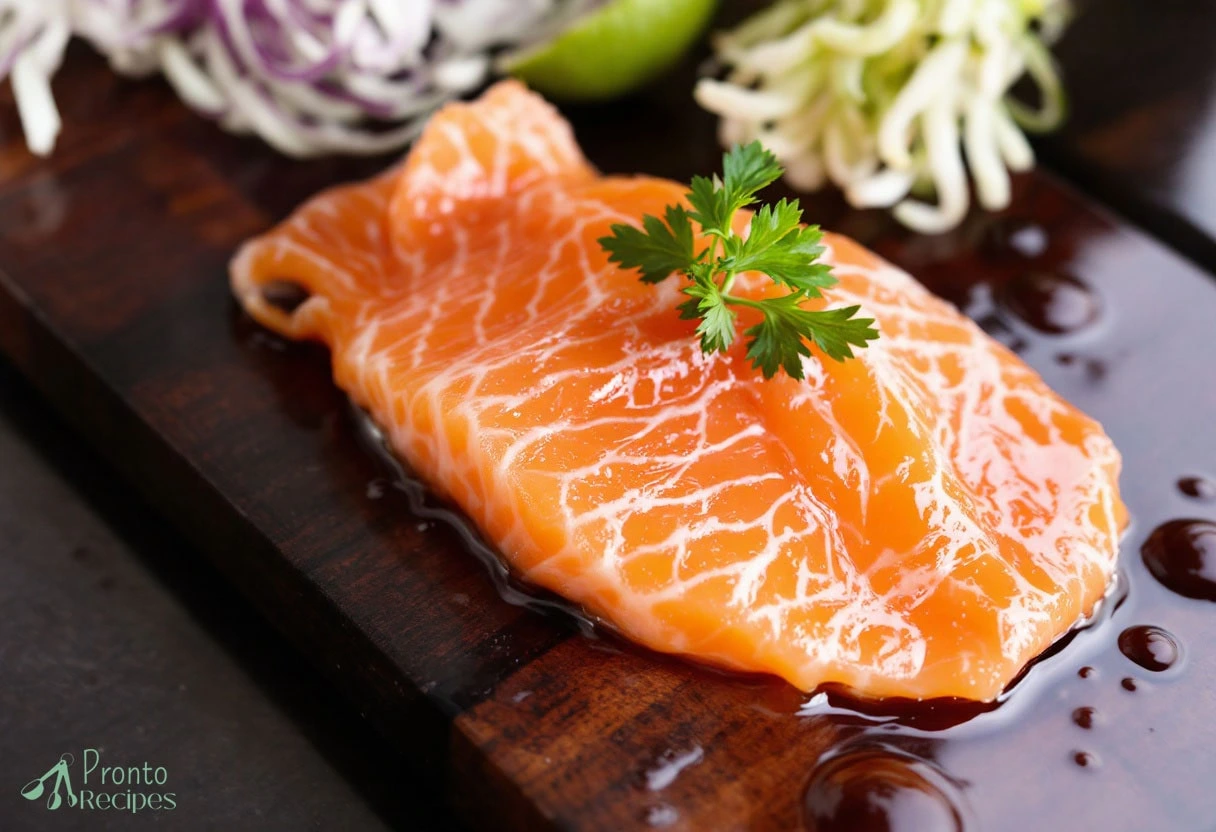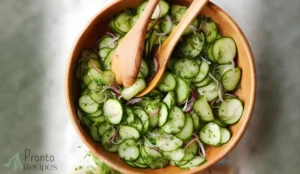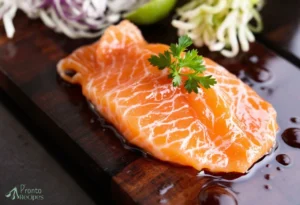The Ultimate Guide to Salmon Sashimi: How to Make It Perfect Every Time
Salmon sashimi is not just a dish; it’s a culinary experience. This delicate, luxurious dish, known for its smooth texture, rich flavor, and vibrant color, has become a favorite among seafood lovers worldwide. Whether you’re new to sashimi or an experienced enthusiast, mastering the art of preparing this dish will elevate your cooking skills and bring the flavors of Japan right to your table.
In this comprehensive guide, we’ll walk you through every step necessary to create the perfect salmon sashimi, from selecting the finest fish to perfecting your slicing technique. By the end of this article, you’ll have the confidence to make salmon sashimi like a professional, impressing your friends and family with your skills.
What is Salmon Sashimi?
Before we get into preparation, it’s important to understand what makes salmon sashimi so special.
Understanding Sashimi
Sashimi is a traditional Japanese dish that consists of raw, thinly sliced fish or seafood served without rice. The name “sashimi” translates to “pierced body,” which refers to the method of slicing the fish. Unlike sushi, which pairs raw fish with vinegared rice, sashimi allows the fish to shine on its own, unadulterated by additional ingredients.
Salmon sashimi is particularly popular due to its rich, buttery texture and mild, sweet flavor. The fish’s high fat content, especially in wild-caught varieties, gives it a luxurious mouthfeel and delicate sweetness. These qualities make it an ideal choice for sashimi, where the natural flavors of the fish are meant to take center stage.
Why Choose Salmon for Sashimi?
Salmon is a favorite choice for sashimi due to its accessibility, flavor, and texture. Here’s why it’s often the go-to fish for this dish:
- Mild Flavor: Compared to more intense fish like tuna or mackerel, salmon’s flavor is mild, sweet, and approachable, making it a great introduction to sashimi for newcomers.
- Health Benefits: Salmon is rich in omega-3 fatty acids, essential vitamins, and high-quality protein. These nutrients not only make it delicious but also provide a nutritional boost to your meal.
- Visual Appeal: With its vibrant orange flesh, salmon sashimi has a striking appearance, making it a visually stunning dish on any plate.
- Firm Texture: Salmon has a firm yet tender texture that holds up well when sliced thinly for sashimi. It’s also versatile, pairing well with a variety of traditional accompaniments like soy sauce, wasabi, and ponzu.
Sashimi vs. Sushi
While both sashimi and sushi are iconic dishes in Japanese cuisine, they differ significantly in how the fish is served:
- Sushi: Involves raw fish served atop vinegared rice, often accompanied by vegetables, seaweed, or other garnishes.
- Sashimi: Refers strictly to raw fish (or other seafood) that’s sliced thinly and served on its own, without rice.
The main distinction is that sashimi emphasizes the purity and quality of the raw fish. By not pairing it with rice, the fish becomes the focal point of the dish, allowing its natural flavor and texture to shine.
How to Select the Best Salmon for Sashimi
The first step in creating perfect salmon sashimi is choosing the right fish. Not all salmon is safe or suitable for raw consumption, so knowing how to select the best fish is key.
What is Sashimi-Grade Salmon?
“Sashimi-grade” is a term used to describe fish that has been handled and prepared in a way that minimizes the risk of parasites and bacteria. Typically, sashimi-grade fish is frozen immediately after being caught to kill any potential pathogens. While this doesn’t guarantee safety, it greatly reduces the risk, making it safer for raw consumption.
Where to Buy Fresh Salmon for Sashimi
To ensure you’re getting the best quality, it’s crucial to buy your salmon from a trusted seafood market, fishmonger, or specialty supplier. While some grocery stores may sell sashimi-grade salmon, it’s always a good idea to ask about the sourcing, handling, and freezing practices to ensure it meets the necessary standards.
Signs of Freshness in Salmon
When selecting salmon, freshness is key. Here’s what to look for:
- Color: Fresh salmon should have bright, vibrant flesh—deep orange or red. Dull, grayish hues can indicate age or poor quality.
- Smell: Fresh salmon should have a clean, ocean-like smell. Avoid fish that has a strong, off-putting odor.
- Texture: The fish should feel firm when pressed. If it’s soft, mushy, or slimy, it may not be fresh enough for sashimi.
Essential Tools for Making Perfect Salmon Sashimi
To prepare salmon sashimi properly, you’ll need a few essential tools:
| Tool | Purpose |
|---|---|
| Sashimi Knife | A long, sharp knife designed for thin, clean slices. A yanagiba (sashimi knife) is the best, but a sharp chef’s knife works as well. |
| Cutting Board | A clean, non-porous board (such as bamboo or plastic) to ensure a sanitary workspace. |
| Fish Tweezers | Fine-tipped tweezers for removing any small bones from the fillet. |
| Fish Scaler | If you’re using a whole fish, this tool helps remove the scales efficiently. |
| Kitchen Towel | A damp towel for wiping down tools between cuts and keeping the workspace clean. |
Having the right tools will make a huge difference in the final product, so it’s worth investing in high-quality items for this purpose.
Step-by-Step Guide to Preparing Salmon Sashimi
Now that you’ve selected your fish and gathered the necessary tools, it’s time to prepare the salmon sashimi.
1. Choose Fresh Salmon
Ensure that the salmon is sashimi-grade, with vibrant color and firm texture. Buy from trusted sources for the best quality.
2. Prepare Your Tools

Ensure your knife is sharp, your cutting board is clean, and you have tweezers on hand to remove any bones.
3. Remove Bones
Using your fish tweezers, carefully check the fillet for any small bones and remove them. This is crucial to avoid any unpleasant surprises when eating the sashimi.
4. Slice the Salmon

Lay the salmon skin-side down on the cutting board. Using your sashimi knife, slice the fish against the grain at a slight angle, aiming for uniform slices around 1/4 inch thick. The goal is to achieve smooth, clean cuts that showcase the fish’s natural texture.
5. Serve Immediately

Arrange the slices on a clean plate in a fanned-out pattern. Sashimi should always be enjoyed fresh; serve it soon after cutting.
Perfect Slicing Techniques
The way you slice your salmon will directly affect the texture and presentation of the sashimi. Here’s a more detailed guide to slicing the fish properly:
- Positioning the Fish: Lay the salmon fillet flat on the cutting board, skin-side down, making sure it’s stable and won’t slip.
- Knife Angle: Hold the knife at a 30-degree angle to the fish. This will allow for thin, delicate slices.
- Cutting Against the Grain: Always slice against the grain of the fish (the lines in the muscle). This ensures the sashimi has a tender, melt-in-your-mouth texture.
- Consistency: Keep your slices uniform in thickness for the best presentation and even texture.
Common Mistakes to Avoid
Avoid these common pitfalls to ensure your sashimi is perfect every time:
- Slicing with the Grain: Cutting along the grain makes the fish tough and chewy. Always slice against the grain.
- Dull Knife: A dull knife will tear the salmon rather than slice through it smoothly. Keep your knife sharp for clean cuts.
- Inconsistent Slices: Make sure your slices are consistent in thickness. Uneven pieces will affect both texture and presentation.
Plating and Serving Salmon Sashimi
Presentation is key when serving sashimi. Here’s how to plate your salmon to make it look as impressive as it tastes:
- Fanned Arrangement: Arrange the slices of salmon in a fan pattern, either in a straight line or a curve, to showcase the vibrant colors of the fish.
- Minimal Garnishing: Keep garnishes light and simple. Thin slices of lemon, microgreens, or a small mound of shredded daikon radish work perfectly.
- Clean Plate: Use a simple, clean white plate to let the fish be the focal point of the dish. Avoid over-cluttering the plate with excessive garnishes.
Traditional Pairings:
Sashimi is traditionally paired with a few key accompaniments that enhance its flavor:
- Soy Sauce: A light soy sauce or tamari works best. The saltiness brings out the umami of the fish.
- Wasabi: A small dollop of wasabi adds a spicy punch. Be cautious—wasabi can be very pungent.
- Ponzu Sauce: For a citrusy, tangy twist, drizzle some ponzu sauce over the sashimi.
- Pickled Ginger: Served on the side, pickled ginger helps cleanse your palate between bites.
Sashimi Etiquette
To fully enjoy the sashimi experience, follow these simple etiquette guidelines:
- Dipping: When dipping sashimi into soy sauce, don
’t immerse the whole slice. Lightly dip just one edge of the fish to avoid overpowering its flavor.
- Chopsticks or Fingers: Traditionally, sashimi is eaten with chopsticks, but it’s perfectly acceptable to eat it with your fingers, especially in more casual settings.
- Eat Immediately: Sashimi should be eaten fresh, right after slicing, to ensure optimal texture and flavor.
Final Thoughts
Making perfect salmon sashimi at home is easier than you might think with the right tools, fresh ingredients, and proper technique. By following this guide, you’ll be able to create a restaurant-quality dish in the comfort of your own kitchen, impressing friends and family with your newfound skills.
So what are you waiting for? Head to your local fishmonger, pick up some sashimi-grade salmon, and get slicing. Your taste buds will thank you!






4 thoughts on “Salmon Sashimi: How to Make It Perfect Every Time”